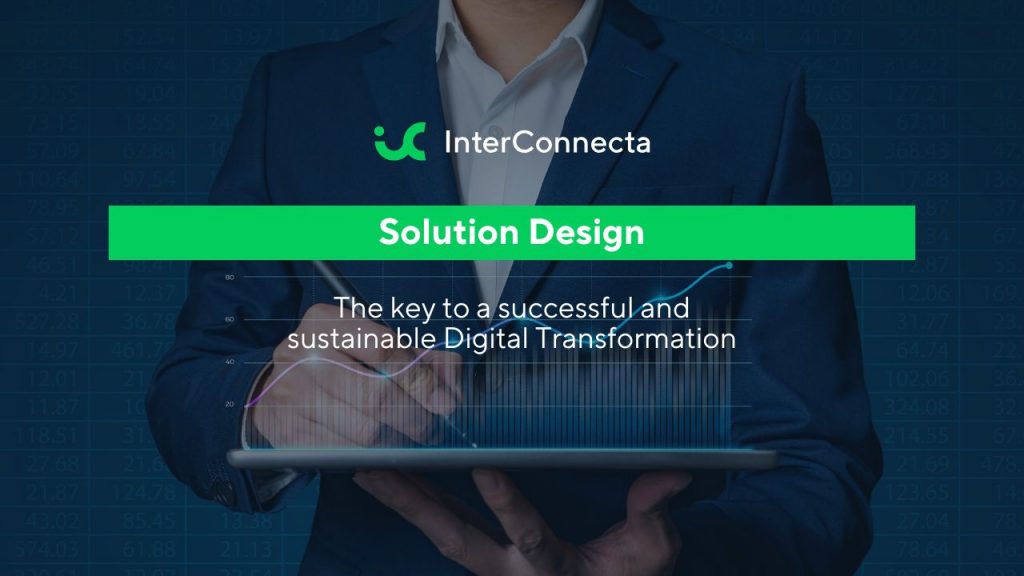
Why do some companies successfully transform their operations while others remain stuck in inefficient processes? The answer lies not only in the technology they adopt but in how they structure their processes to effectively integrate these tools.
Today, many organizations embark on their digital transformation journey with the idea that implementing new software will solve their operational problems. However, without prior assessment and proper solution design, the risk of creating more complexities than benefits is high.
This is where Solution Design comes into play. More than just a technical stage, it is a strategic approach that allows companies to analyze, redesign, and optimize processes before adopting new tools. This methodology not only improves efficiency and reduces unnecessary costs but also ensures that digitalization truly drives the business forward.
Solution Design as the foundation of Digital Transformation
Digital transformation begins with a fundamental question: How can processes be optimized so that technology drives the business and not the other way around? Many organizations implement software without analyzing whether their operational structure is ready for change, leading to inefficiencies, high costs, and internal resistance that can jeopardize the project’s success.
Solution Design enables the alignment of technology with the company’s strategic objectives. This approach not only focuses on implementing new tools but also identifies opportunities to improve workflows, eliminate redundancies, and establish clear criteria for adopting new platforms.
1. Analysis and Diagnosis of Existing Processes
Before implementing any digital solution, conducting a detailed diagnosis of current processes is essential. This phase assesses key aspects such as:
- Bottlenecks and redundancies: Are there unnecessarily repetitive processes slowing down operations?
- Interdepartmental dependencies: How do different departments interact, and what impact does this have on overall efficiency?
- Workflow gaps: Where do friction points arise that affect productivity?
By conducting interviews with key leaders and users, analyzing data, and mapping processes, businesses gain a clear understanding of their needs and areas for improvement.
2. Process Design and Enterprise Architecture
Once the current state of processes has been identified, the next step is designing solutions to optimize operations and prepare them for technology implementation. This phase focuses on:
- Developing scalable workflows: Designing processes that not only solve immediate problems but also support future growth.
- Defining acceptance criteria: Establishing clear indicators to evaluate whether end users are correctly adopting the proposed improvements.
- Optimizing security and information access: Adjusting roles and permissions to ensure the protection of sensitive data without compromising operational efficiency.
This structured approach minimizes risks and ensures that digital transformation does not disrupt critical operations.
3. Phased Implementation and Performance Monitoring
Effective digital transformation does not happen overnight. To prevent disruptions, it is crucial to develop a phased action plan, prioritizing high-impact implementations with lower complexity.
- Implementation stages: Divided into manageable phases to allow for gradual adjustments without affecting operational continuity.
- Detailed budget: A financial breakdown with return on investment (ROI) projections ensures that each improvement has a measurable impact.
- Ongoing evaluation: Periodic assessments help adjust the strategy based on process evolution and team adoption.
Benefits of a Solution Design-Based Approach
Companies that adopt a structured approach to digital transformation maximize operational efficiency and reduce unnecessary costs before making significant technology investments.
Some key benefits include:
✅ Operational efficiency: Increased productivity and better resource allocation.
✅ Cost reduction: Identifying and eliminating inefficiencies before investing in software or infrastructure.
✅ Risk minimization: Gradual implementations prevent operational disruptions.
✅ Scalable growth: A digital infrastructure adaptable to business evolution.
Preparing Processes for Artificial Intelligence
One of the key differentiators of Solution Design is that it not only optimizes current processes but also prepares them for the future, especially for the adoption of Artificial Intelligence (AI)-based solutions.
💡AI-ready solutions: we design business processes that are ready to integrate AI tools, whether within the Zoho ecosystem, third-party applications, or any other business platform.
This involves structuring workflows that can be automated, identifying areas with potential for predictive analytics or data-driven decision-making, and ensuring that current systems can scale with emerging technologies.
In other words, solution design is not just a preliminary step before implementing a CRM or ERP: it is the foundation that enables your company to leverage AI effectively and sustainably.
(You may also be interested in: “Adopting AI: The Key to Modernizing Business Operations”)
Digital transformation is not just about technology; it’s about strategy. Solution Design and process optimization enable companies to make more informed decisions and build a solid foundation for digitalization. Adopting a data-driven approach, defining clear objectives, and designing efficient workflows is the key to a successful and sustainable technology implementation.
The future of companies lies not in simply adopting software but in their ability to redesign processes and leverage technology intelligently.
Ready to optimize your processes and accelerate your digital transformation? Download our brochure to learn in detail how Solution Design can help your company structure efficient and scalable processes.
Additionally, discover in this video how our solutions adapt to your business needs and facilitate the strategic implementation of technology.
🎥 Watch the video below:



